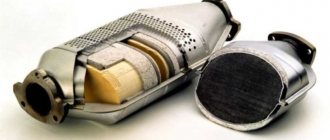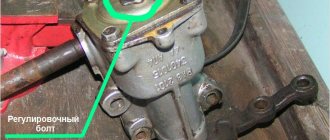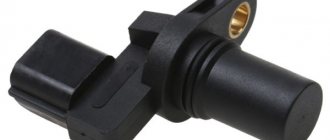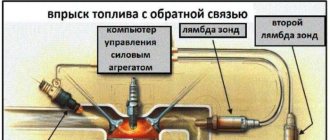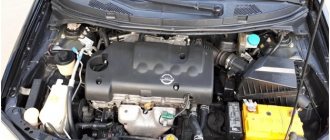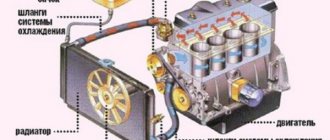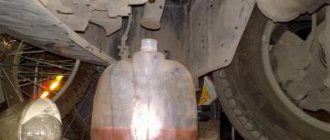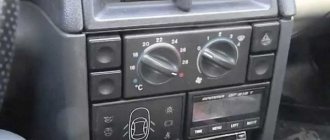Cars of the Samara-2 family (VAZ 2113, 2114, 2115) are equipped with a closed-type cooling system with forced circulation of coolant. The system maintains excess antifreeze pressure, which creates an increased boiling point and allows the liquid to heat up to 110-115°C.
1 – expansion tank plug; 2 – extended
Antifreeze, located in the cooling jacket of the cylinder head and block, removes the heat generated during fuel combustion in the engine. Fluid circulation is ensured by a centrifugal-type water pump (pump), which is driven by a timing belt. The cooling mode is set by a thermostat: at temperatures below 85°C, antifreeze flows in a small circle, providing quick warm-up of the engine, and when the value reaches 85 degrees, the thermostat opens a large circle, and hot antifreeze enters the radiator. When the car moves, the antifreeze in the radiator is cooled by blowing with a flow of oncoming air and then returns through the pipes to the engine block.
The antifreeze temperature is monitored by a sensor in the thermostat housing, information from which goes to the instrument panel indicator and to the car's ECU. When the antifreeze heats up to a certain temperature (95°, 98°, 105° - depending on the settings of the control unit), the electric motor of the fan located on the inside of the radiator automatically turns on. Also, on front-wheel drive VAZs, antifreeze from the engine transfers heat to the heater radiator to heat the interior.
An expansion tank with an antifreeze level sensor is used to fill the system with liquid. The total capacity of the VAZ 2114 system depends on the modification and averages 7.8 liters.
Main causes of leaks
Cooling of the VAZ-2114 is carried out as follows:
- coolant from the tank enters the water circuit (“jacket”) of the engine;
- antifreeze circulates in the “jacket” in a small circle until it reaches +95° C along with the engine;
- the thermostatic valve opens and antifreeze is delivered to the radiator for cooling;
- excess liquid that is formed as a result of expansion during heating is returned to the expansion tank.
Thus, sources of antifreeze or antifreeze leakage can be:
- The expansion tank itself - under the influence of alcohol antifreeze, cracks may appear on it.
How to detect a leak
The easiest way to detect the cause of the leak is if antifreeze leaves the expansion tank of the VAZ 2114. In this situation, the liquid may end up under the driver's mat or the hood of the car.
Also, to understand exactly where the leak is located, you can put a sheet of cardboard or paper under the hood and start the engine for about half an hour. Drops on the sheet will indicate the location of the leak.
To find out exactly where the VAZ 2114 antifreeze goes, you need to conduct a thorough inspection of the cooling system:
- Hoses and pipes - usually cracks on them are visible immediately upon inspection. If coolant leaks at the joints, oily traces indicate a leak.
- Radiator – this is where the leak is harder to notice due to scale or dirt. Therefore, it is recommended to carry out a pressure test. The upper pipe from the radiator is disconnected, plugged, and pressure is built up with a compressor. If a leak appears, the radiator must be removed and welded.
- Thermostat (in the injection model, located under the air filter) - in this case, the valve “jamming” is observed, since it is subject to mechanical stress and high temperatures.
- Engine jacket - in this case, the engine begins to “trouble”, and a large amount of steam comes out of the exhaust pipe. At the same time, engine oil becomes gray in color and changes consistency.
- Expansion tank cap - to check this cause of the leak, you need to start the engine by removing the cap from the tank and holding down the accelerator. If the fluid level rises sharply, then there is a leak here.
- The cylinder head gasket is worn or loose. In places of leakage, coolant usually “bulges out”. Also in this case, antifreeze or antifreeze may get into the engine oil.
Torn cylinder head gasket VAZ 2114
Important! If a characteristic odor enters the cabin or white steam is formed coming from the exhaust pipe, it means that coolant has entered the engine oil. If antifreeze circulates in the system, the engine cylinder head may fail due to this. If VAZ 2114 antifreeze is leaking, then getting into the oil does not lead to such critical consequences, but still the leak must be eliminated as quickly as possible.
Fix it yourself or go to a service station?
Once again I want to draw your attention, this is very important! All work on replacing cooling system elements is carried out exclusively with the engine turned off and the coolant cooled down.
You can replace the pipes, thermostat, radiator filler cap, and expansion tank cap yourself. Remove the filler cap on the radiator. Unscrew the drain plug on the engine and drain the coolant into a clean container.
As for replacing the gasket between the valve head and the piston block, repairing a rotten engine cooling jacket and repairing radiators, these works are best done at specialized stations.
Since such repairs will require the use of specific tools and the necessary experience and knowledge.
The interior of the car was disassembled after an antifreeze spill, and at the same time noisy, since the factory heat and sound insulation had become unusable
Before finding the reasons for the smell of antifreeze in the cabin, you need to understand the design of the cooling system.
So, let's look at how the engine coolant system works:
Scheme and design of the cooling system
1 – expansion tank plug; 2 – expansion tank; 3 – coolant drain hose from the throttle pipe; 4 – hose from the radiator to the expansion tank; 5 – radiator outlet hose; 6 – left radiator tank; 7 – aluminum radiator tubes; 8 – plug; 9 – right radiator tank; 10 – drain plug; 11 – radiator core; 12 – electric fan casing; 13 – electric fan impeller; 14 – electric motor; 15 – pump gear pulley; 16 – pump impeller; 17 – camshaft drive toothed belt; 18 – engine block; 19 – pump supply tube; 20 – radiator supply hose; 21 – heater radiator outlet hose; 22 – coolant supply hose to the throttle pipe; 23 – exhaust pipe; 24 – filling hose; 25 – heater radiator supply hose; 26 – thermostat; 27 – coolant temperature sensor; 28 – coolant level indicator sensor
Reasons for the appearance of antifreeze under the rugs and on the bottom of the VAZ-2114
It’s good if the weather is warm outside, it will dry quickly. If it's frosty outside, you'll have to heat it up.
So, when the issue of the design of the cooling system has been considered, we can proceed directly to considering the reasons for the appearance of the smell of antifreeze in the car interior:
- Problems with the cooling system pipes.
- The heater radiator is faulty.
- The interior floor is filled with antifreeze.
- Smell from a new heater radiator.
- The smell is coming from the engine compartment.
The main reasons have been identified, and now we can proceed directly to considering methods for eliminating the effect.
Elimination methods
There are several reasons for the smell of antifreeze in a car. Of course, to eliminate this you will need some tools, as well as knowledge of the design of the VAZ-2114 cooling system, which was discussed above.
Stove faucet
In the process of replacing the stove valve
One of the most common reasons. In this case, the antifreeze will be mainly under the driver's mat. The faucet can only flow in certain modes, for example, in heat. Therefore, when diagnosing the heater valve, try turning on different heater modes.
Problems with the cooling system pipes
Leaking coolant system pipes
The most common reason for the smell of antifreeze in the car interior is that cracks appear in the heater pipes, which cause coolant to leak onto the radiator. When heated, this element causes antifreeze to evaporate in the cabin, which actually causes this effect.
The elimination method, in this case, is simple - inspect the inlet and outlet pipes of the stove, and if cracks are found, they must be replaced. Diagnostic operations must be carried out hot, with the interior heating system running.
Heater radiator is faulty
Faulty heater radiator
The heater radiator repeatedly causes the smell of antifreeze to appear in the cabin, which flows out of it and evaporates. In this case, it is necessary to disassemble the heating system and diagnose the stove radiator. If cracks or defects are found on it, the part must be replaced with a new one.
Reasons for the smell of antifreeze in the cabin
The sweetish smell of antifreeze in the cabin, especially noticeable after turning on the heater, always indicates one thing: there is a coolant leak in the system. There are four main ways antifreeze vapor can enter the cabin.
There are several reasons for the destruction of pipes, radiators (central and heater), as well as other elements of the cooling system:
When the smell of antifreeze first appears in the car interior, you need to check the tightness of the system. Please note: some antifreezes contain special fluorescent components that glow under ultraviolet radiation. This helps to find even a small leak.
Causes of malfunctions
In some cases, the fact that the furnace is blowing cold air is normal. For example, when you turn it on in ventilation mode. But if you switch to heating mode, but the heater is not going to blow hot air, you are faced with a breakdown.
Specialists at the service station will tell you that there can be many reasons for the breakdown. This is another reason to take more money. Therefore, it is in your interests and for reasons of economy to check each reason yourself. Besides, it's not that difficult. Among the main reasons why the stove on the VAZ-2114 stopped working and producing hot air may be:
- broken fan;
- airlock;
- stove tap;
- radiator;
- insufficient pressure;
- antifreeze deficiency;
- cylinder head gasket;
- motor.
As you can see, there are enough options for why the system stopped working.
Important! If you decide to do the repairs yourself, start with the most likely and simplest reasons for the failure of the heating system. It is better to entrust complex stages in the absence of relevant experience to specialists.
Fan
Warm or hot air may not flow from the stove if the fan is not activated from the start. In this situation, you will have to completely disassemble the stove and look for the cause inside it.
To avoid unnecessary dismantling work, start the engine and turn on in turn all the power levels at which the fan operates. If there is no noise or any movement, then you will still have to disassemble the system and change the fan or its motor.
Important! The thermostat is another potential culprit when the heater does not want to turn on. A faulty thermostat causes the coolant to circulate, but does not have time to cool.
Airlock
Quite often, VAZ-2114 stoves do not heat well due to the fact that an air lock has formed inside the cooling system. It appears mainly in cases where the engine has already stopped working. From this moment on, the temperature of the coolant begins to drop. In such situations, air is able to leak into the upper part of your VAZ-2114 radiator, after which the plug penetrates the thermostat.
The next time you start the engine, the heater may not turn on. This is due to the fact that when the engine starts, the pump drives accumulated air through the thermostat into the heater radiator. In some cases, because of this, VAZ-2114 stoves only heat up at speed. Therefore, before sending the car to a service station, simply try to get rid of air in the system. Although there are other possible reasons for the lack of heat at idle and its appearance after pressing the gas. This is the heater valve or the same cylinder head gasket.
Important! There is a fairly simple way to get rid of an air lock. To do this, remove the pipe and gradually fill in antifreeze to the maximum level.
Faucet
As experts and VAZ-2114 owners themselves, who have encountered problems with the heating system, note, it is because of the faucet that hot air most often stops flowing.
It does not open completely, which leads to an uncomfortable temperature inside the car. Moreover, heat does not come out of the stove for two reasons related to the faucet:
- The element has completely stopped performing its functions, that is, it needs to be replaced with a new one.
- The fixation of the stove faucet is broken due to a loose cable. It is located in the pedal area. To adjust and restore tension, grab the element with pliers and try to tighten it.
Important! If there is no supply of hot air to the interior of the VAZ-2114, and at the same time there are leaks from the faucet, then it must be urgently and urgently replaced.
What should a car enthusiast do?
First of all, carry out a complete diagnosis of the car's cooling system. This can be done in the garage, without complex devices and without special knowledge and skills. But you need to carefully remove the smell of antifreeze. Open the hood, check the pipes, hoses and covers for visible damage. Absolutely all system conductors must be checked. We replace damaged parts.
Another cause of a leak may be a malfunction in the engine crankcase. Failure leads to disruption of the functionality of the power unit. To diagnose, just look at the oil tank cap from the inside. If coolant gets on the engine crankcase, a white coating forms on the cover.
As a result of the leak, coolant can penetrate directly into the passenger compartment. This indicates a malfunction of the radiator. If a leak forms in it, some of the coolant penetrates into the cabin, where a characteristic sweetish smell is felt. We replace the radiator with a new one and remove the liquid. This can be done by placing newspapers on the puddle, which we throw away as they become soaked. Someone uses a plastic bottle. We make a hole in its lid, then squeeze the bottle to release air from it and apply the hole to the spilled moisture. In 3-4 passes, you can “suck out” the entire puddle in this way, and wipe off the remaining moisture with a rag.
The cause of the leak can be difficult to determine. If the source of suspicious traces cannot be identified, look at the radiator of the heating system. Coolant may also leak from the heater. Then an unpleasant burning smell is felt in the cabin. Leaking liquid will get under the mat. To fix the problem, you will have to replace the stove radiator by first disassembling its body.
The reason may not be in the radiator itself, but in the tubes connected to it. The joints can be treated with sealant. But it is better to immediately replace the problematic tubes with new ones.
To prevent the appearance of coolant vapors in the cabin, you need to check the level in the radiator from time to time. The evaporated liquid should be replenished, and if the evaporation is too intense, the cause of the problem should be urgently determined.
On thematic forums, it is advised to use the coolant of the brand that is recommended for use in your specific car model. It is not recommended to mix coolers of different types. Timely diagnostics of the cooling system will allow you to identify faults and increase the service life of the power unit elements.
Read more: Replacing a CV joint on a Honda Civic 4D
Whats up all. The smell of antifreeze enters the interior when the heater is turned on, has anyone encountered this ?What is the problem?
Why does antifreeze leak?
The engine cooling system consists of several main elements, as well as connecting pipes. Antifreeze in the system is a mixture of water and concentrate in certain proportions. As the internal combustion engine heats up, the temperature of the coolant also increases; the coolant itself is in the system under a certain pressure. It is quite obvious that any defects in individual components associated with tightness will cause leaks. Problems can arise both with the elements themselves and with the pipes. Let us add that in some cases the driver may encounter the fact that antifreeze leaks when cold, leaks appear after the internal combustion engine warms up, the leak can be intense or unnoticeable (antifreeze leaves slowly or quickly), etc.
One of the primary signs that indicates a problem is the coolant level in the expansion tank. If a constant decrease is noted, then this indicates a problem. An exception is that during the operation of the car the level in the tank decreases slightly naturally. This is not a malfunction. For example, in cold weather, coolant tends to decrease somewhat in volume. On a working engine, after warming up the level should return to normal. In the summer, when the cooling system is working at its limit, the water in the coolant evaporates. In this case, topping up is carried out. If the level in the tank drops more intensely, then the system needs diagnostics.
Clear downgrade problems
This is not entirely relevant to our question, but it’s worth mentioning. This needs to be checked first, and if you have not identified the reasons, then we will dig deeper. So, antifreeze may leak due to a leak in the system, let’s look at it point by point:
- Engine radiator leaked . Of course, this can be determined very quickly, just look at it and also look at the stains under the car; if it is leaky, there will be red, green or blue drops. Of course, you can try to solder or clamp the radiator tubes, but often the plastic component (sidewalls) is damaged, there is nothing you can do about it, you need to replace it.
- Heater radiator . Almost the same picture, only the interior heater is leaking, it is more difficult to diagnose, because the coolant will drip onto the seal (carpet) in the cabin. But the reasons for the determination are simple: if there is a smell of antifreeze in the cabin (sweet smell), but not outside. If the glass sweats even in dry weather, and there is an oily coating on the glass. Liquid leaving the tank means your heater radiator is covered, of course, if you remove the plastic (decorative) protection of the instrument panel, you will see that it is dripping somewhere. We do the same, either restore it, or if this is impossible, change it.
- Hoses . They wear out over time, because they expand each time (when the engine heats up) and contract (when it cools down), such work will sooner or later damage them, they will not be able to hold pressure and will rupture. Of course, there may be minimal damage, but it will leak constantly. It is useless to make hoses; it is better to replace them.
- Tubes _ The situation is the same as with hoses, they are metal and usually last a long time. But there are situations when they also occur.
- Thermostat and pump . These are two mechanisms that are designed to pump and regulate the flow of coolant; the housings are made of metal or plastic and they often leak, this happens from time to time. For replacement, they are practically not repaired.
- The cap of the expansion tank and the tank itself. The cap is a valve , after a certain mileage it also fails, if it does not hold pressure, then antifreeze from the expansion tank can splash out when warming up. The tank itself may also burst, because it is made of plastic; if the lid is faulty, it may rupture. For replacement.
These are obvious reasons, they are worth checking first - ALWAYS! It often happens that the driver searches and cannot find it, but antifreeze (antifreeze) goes into, say, the stove and then into the passenger compartment, which is quite difficult to immediately determine. Park the car in a dry area or in a garage, if possible, and observe, if there are stains the color of your coolant, then this is definitely a leak, look for it!
What can a breakdown lead to?
If you notice a specific smell in the car's interior, this can primarily negatively affect the operation of the engine. If coolant leaks, the engine temperature may increase, which will affect its performance. Also, inhaling antifreeze vapors can negatively affect the well-being of both passengers and the driver. The smell of antifreeze in the cabin when the heater is turned on increases the amount of harmful fumes several times, so in winter it is worth eliminating the malfunction as early as possible. Otherwise, breathing in the car will become dangerous to your health. In addition, you can get severe poisoning.
Operating the engine with insufficient coolant can affect the comfort and reliability of the car, namely:
- the heating system does not work at full capacity;
- due to the fact that the engine operates at elevated temperatures, it may fail;
- rupture of pipes and radiators can occur when residual antifreeze boils.
Method 2
A more sophisticated and effective way to get rid of a traffic jam is to create pressure in the system by the owner of the car himself. Briefly, the essence of the method is the following steps:
- Unscrew the engine oil filler cap;
- Remove the rubber gasket from it and return the cover to its place;
- Next, unscrew the cap from the expansion tank;
- Release one of the tubes leading to the throttle from the clamp and remove it from the metal pipe;
- Cover the neck of the tank with your mouth and blow into it, creating pressure in the circuit;
- After the antifreeze begins to flow out of the pipe without bubbles, put it in place and tighten it with a clamp;
- Reassemble the removed parts in reverse order.
This method may seem unsafe, because... There is a risk of inhaling antifreeze vapors when blowing air, but at low temperatures this procedure is safe. If the cooling system is still not free of the plug, use the following method.


